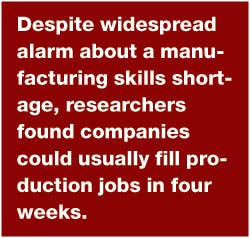Timken Co. (IW 500/197), a manufacturer of tapered bearings and of specialty steels, developed a partnership with the University of Akron and transferred Timken's coatings laboratory, its equipment and several of its key researchers to the university. Out of this pooling of resources has come a new graduate degree program, a new consortium on coatings and engineered surfaces and the potential for start-up firms based on research supported by the consortium, such as a set of promising coatings technologies that had been "stranded" in a bearings company.
See Also: Manufacturing Innovation & Product Development Strategy
"While companies from outside the region might join, much of the value from participation will derive from face-to-face presence in the labs at the University of Akron, from being able to use university labs (funded in part at least with public money) instead of keeping these facilities in-house, and from the chance for local companies to hire graduates."
As the Timken example shows, new forms of collaboration and risk-sharing, often through public-private partnerships or industry-university agreements, can help a wide variety of manufacturers and industries to innovate and grow, according to a preliminary report on an MIT research study of how production contributes to innovation in the U.S. economy
The MIT study, called Production in the Innovation Economy (PIE), involved two years of research by 20 MIT faculty members and looked at 255 manufacturing companies, 178 of which were located in the U.S.
Collaboration and support at the local or regional level is badly needed if the often hollowed-out U.S. manufacturing community is to fully benefit from innovation, MIT researchers found.
"In the Main Street manufacturers we interviewed in the U.S. they usually had only their own material, human and financial resources to draw on when they tried to scale-up an innovation," the report notes. By contrast, it found that German manufacturers "had not only their own legacy resources, but also access to a rich and diverse set of complementary capabilities in the industrial ecosystem: suppliers, trade associations, industrial collective research consortia, industrial research centers, Fraunhofer Institutes, university-industry collaboratives, technical advisory committees."
"It has been suggested by previous reports that sustaining the strength of U.S. manufacturing is essential to America's future; a strong advanced-manufacturing base is crucial to national security and it represents a key source of good-paying jobs," MIT President L. Rafael Reif says, adding that the new study shows "local production is very important to sustaining a vibrant innovation ecosystem in a region. Thus, we must also take steps now to regain U.S. manufacturing momentum if we want to sustain the nation's signature economic advantage: innovation."
The report finds that manufacturing should not be regarded as a small group of traditional, shrinking industries but rather as a diverse, evolving group of industries from which new products and knowledge frequently emerge.
"There is no reason manufacturing has to disappear in an advanced industrial society," says Suzanne Berger, an MIT political science professor and co-chair of the PIE commission.
Moreover, the report warns again that "as U.S. companies shift the commercialization of their technologies abroad, their capacity for initiating future rounds of innovation will be progressively enfeebled. That's because much learning takes place as companies move their ideas beyond prototypes and demonstration and through the stages of commercialization."
MIT intends to publish two books based on the research in the fall but some findings shared so far:
- Many multinationals are concerned about encountering quality control problems if their R&D and production staffs are on opposite sides of the world. "Companies that had separated manufacturing from product design are recognizing that they're losing opportunities to be efficient or product better products," says Martin Schmidt, an MIT professor of electrical engineering and computer science.
- Financing issues are often critical for startups, since it can take 12 to 15 months for them to bring in revenue. Being located near other firms with complementary products and abilities can be a critical factor in startups successfully moving into production.
- Small-to-mid-sized firms often innovate by taking existing technologies or techniques and applying them to make new products. These companies also benefit from being located in a diverse industrial ecosystem where they can tap into resources such as training or opportunities for collaborative research.
- Despite widespread alarm about a manufacturing skills shortage, researchers found companies could usually fill production jobs in four weeks. The study found less than 20% of firms have long-term (three months or more) job vacancies, equivalent to about 5% of core production jobs. The biggest problems manufacturers face in filling jobs involve job skills not usually available in a particular region; jobs requiring advanced math; and jobs in very small companies, which may lack the local connections to bring in workers.





